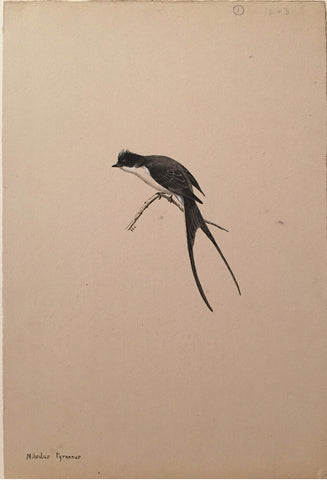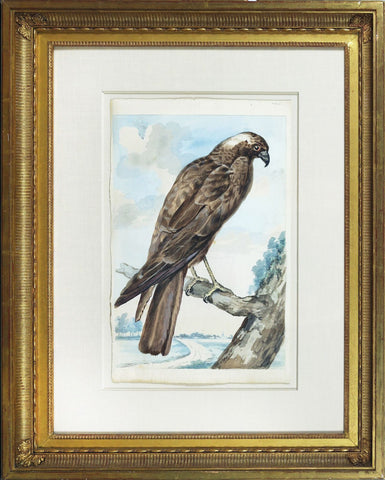
George Edward Lodge (British, 1860-1954), “Fork-tailed Flycatcher”, Milvulus Tyrannus.
George Edward Lodge (British, 1860-1954)
“Fork-tailed Flycatcher”, Milvulus Tyrannus.
Ink, watercolor and gouache on paper
Titled and signed ‘G.E.L’
Paper size: 6 1/4” x 9”
The fork-tailed flycatcher (Tyrannus savana) occurs in a wide variety of habitats including pastures, riparian forests, and open residential areas with scattered trees. Its breeding range is from central Mexico to central Argentina. In most of this range it is usually found year-round, but in the southern parts of its range it retreats northward for the winter. This species is also known to wander widely. It occurs almost annually in the eastern United States seaboard and Canada.
The fork-tailed flycatcher is white below, gray above, and has a black cap. Males sometimes show a yellow crown stripe. Males also have an extremely long forked tail, of even greater length than that of their cousin, the scissor-tailed flycatcher. Females have a somewhat shorter tail, while it is significantly shorter in juveniles.
This species is primarily an insectivore but will switch to berries and small fruits during winter if insects become scarce.
GEORGE EDWARD LODGE (BRITISH, 1860-1954)
“A man of most exceptional charm and distinction, [Lodge] was recognized on both sides of the Atlantic as one of the finest bird-artists this country has ever produced. His wide experience in falconry doubtless gave him special knowledge of the hawk family, for he was a keen falconer from his earliest days. In the painting of birds of prey he had no rival in any country. He was primarily an artist but, being a good naturalist as well, he was able to depict his subjects among their natural surroundings and to make them look alive.” “
(Obituary, The Times, 9 February 1954.)
Prepared for the Longmans’s “readership series” of books. Throughout his long life, Lodge illustrated over sixty books, including 389 plates of 426 species for David Bannerman’s “Birds of the British Isles,” a twelve volume epic, which he undertook at the age of 92.
Please feel free to contact us with questions by phone at 215.735.8811,
or by email at loricohen@aradergalleries.
We Also Recommend





